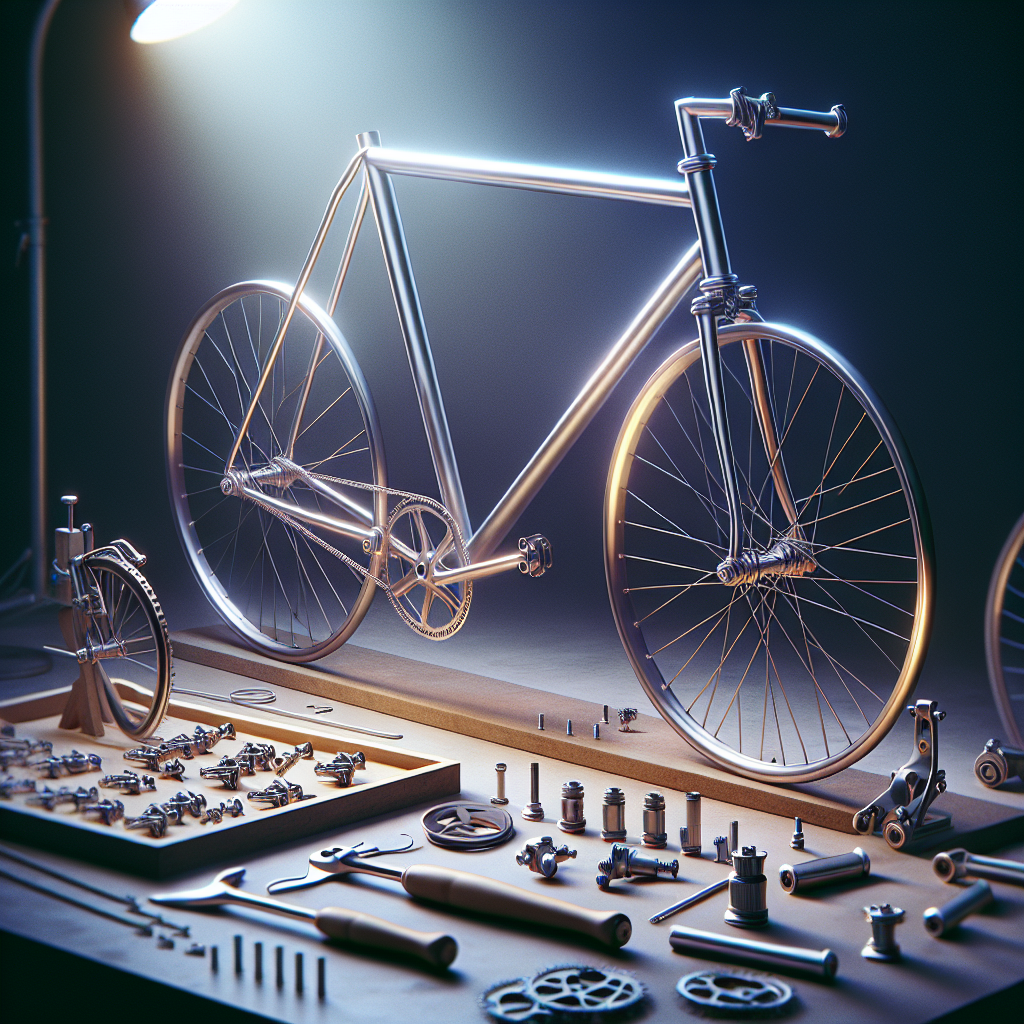So, you’ve decided to take on the exciting project of building your own bicycle? That’s fantastic! In this article, we will guide you through the step-by-step process of building a bicycle from scratch. Whether you’re a newbie or an experienced DIY enthusiast, we’ve got you covered. From selecting the right parts to assembling them with precision, we’ll provide you with all the necessary information and tips to make this construction project a success. Get ready to roll up your sleeves and embark on an unforgettable journey of creating your very own customized bicycle that fits your style and needs. Let’s get started!
Choosing the Right Bicycle Parts
Selecting the Frame
The first step in building a bicycle is choosing the right frame. The frame is the foundation of your bike and plays a crucial role in determining the overall feel and performance of the bicycle. When selecting a frame, you need to consider factors such as material, size, geometry, and intended use. Common frame materials include aluminum, steel, carbon fiber, and titanium, each offering its own advantages and characteristics. It’s important to choose a frame size that fits your body type and riding style. Additionally, the geometry of the frame, such as the head tube angle and wheelbase, can affect the handling and stability of the bike. Consider these factors carefully to ensure that you choose a frame that meets your specific needs and preferences.
Choosing the Wheels
Next, you’ll need to choose the right wheels for your bicycle. Wheels are a crucial component that greatly impact the ride quality, performance, and overall durability of the bike. When selecting wheels, you’ll want to consider factors such as rim material, spoke count, and hub type. Aluminum rims are a popular choice for road and mountain bikes due to their lightweight and durable nature. Carbon fiber rims offer increased stiffness and aerodynamic advantages but can be more expensive. The spoke count and lacing pattern can affect the strength and stiffness of the wheels, while the hub type determines the compatibility with different drivetrain systems. Consider your riding style, terrain, and budget when choosing the wheels for your bicycle.

Picking the Right Fork
The fork plays a crucial role in the overall comfort, control, and handling of your bicycle. When selecting a fork, you’ll need to consider factors such as material, suspension type, and axle compatibility. Common fork materials include steel, aluminum, carbon fiber, and titanium, each offering its own advantages in terms of weight, stiffness, and vibration damping. Suspension forks are commonly used in mountain bikes to absorb shocks and bumps, while rigid forks are preferred for road and commuter bikes for their simplicity and efficiency. Additionally, you’ll need to ensure that the fork is compatible with your chosen wheel size and axle standard. Consider your riding style, terrain, and personal preferences when picking the right fork for your bicycle.
Selecting the Handlebars
Choosing the right handlebars is essential for comfort, control, and overall riding experience. Handlebars come in various shapes and styles, each designed to accommodate different riding positions and preferences. Common types of handlebars include drop bars, flat bars, riser bars, and bullhorns. Drop bars are commonly used in road bikes and provide multiple hand positions for long-distance rides. Flat bars are popular in mountain bikes and provide a more upright riding position. Risers bars offer a higher hand position and added control for off-road riding, while bullhorns provide a more aerodynamic position for speed-oriented riding. Consider your riding style, intended use, and personal preferences when selecting the handlebars for your bicycle.

Choosing the Drivetrain
The drivetrain is the heart of your bicycle, consisting of components such as the chainrings, cassette, derailleurs, and shifters. When choosing a drivetrain, you’ll need to consider factors such as the number of gears, gear ratios, and compatibility with your chosen frame and wheels. The number of gears will depend on your riding needs and terrain. Road bikes typically have 2x or 3x front chainrings, while mountain bikes may have 1x, 2x, or 3x setups. Gear ratios determine the range of gears you have available and can greatly impact your ability to climb hills or maintain speed on flat roads. It’s important to ensure that your chosen drivetrain components are compatible with each other and that they fit your frame and wheel specifications. Consider your riding needs, terrain, and desired gear ratios when choosing the drivetrain for your bicycle.
Picking the Brakes
Selecting the right brakes is crucial for safety, control, and overall stopping power. There are several types of brakes to choose from, including rim brakes, disc brakes, and hydraulic brakes. Rim brakes, such as caliper brakes and V-brakes, use friction between brake pads and the rim surface to slow down and stop the bicycle. Disc brakes, on the other hand, use a rotor and brake caliper to provide more consistent and powerful braking performance in various weather conditions. Hydraulic brakes offer even more stopping power and modulation by using fluid to transfer force from the brake lever to the brake caliper. Consider your riding style, terrain, and personal preferences when picking the brakes for your bicycle.

Selecting the Seat and Seatpost
Choosing the right seat and seatpost is essential for comfort and proper bike fit. The seat, also known as the saddle, comes in various shapes, sizes, and materials. It’s important to choose a seat that matches your riding style, body type, and personal preferences. Seats with more padding are often preferred for recreational and leisure riding, while seats with less padding are preferred for more aggressive riding styles. The seatpost is the component that attaches the seat to the frame and allows for adjustments in saddle height and fore-aft positioning. Consider the width, shape, and material of the seat, as well as the length and adjustability of the seatpost, to ensure a comfortable and proper fit for your bicycle.
Choosing the Pedals
Choosing the right pedals is important for efficient power transfer and overall riding comfort. There are several types of pedals to choose from, including platform pedals, cage pedals, clipless pedals, and combination pedals. Platform pedals are the most common type and offer a large platform for your feet, making them suitable for casual riding and commuting. Cage pedals have straps or clips to secure your feet to the pedals, providing added control and efficiency. Clipless pedals use a cleat system and special cycling shoes to securely attach your feet to the pedals, allowing for improved power transfer and pedaling efficiency. Combination pedals offer the versatility of both platforms and clipless pedals. Consider your riding style, intended use, and personal preferences when choosing the pedals for your bicycle.

Picking the Tires
Choosing the right tires is crucial for traction, comfort, and overall riding performance. The type of tires you choose will depend on your riding style, terrain, and intended use. Road bike tires are designed for smooth, fast riding on pavement and typically come in narrow widths and slick or lightly treaded patterns. Mountain bike tires, on the other hand, are designed for off-road riding and come in a variety of widths, tread patterns, and casing options. Gravel and adventure bike tires offer a balance between road and off-road performance, with wider widths and more aggressive tread patterns. Consider the terrain you’ll be riding on, the weather conditions you’ll encounter, and your desired balance of traction and rolling resistance when picking the tires for your bicycle.
Selecting the Accessories
Once you’ve chosen all the major components for your bicycle, it’s time to select the accessories that will enhance your riding experience and meet your specific needs. Accessories can include items such as lights, fenders, racks, panniers, bells, and computer systems. Lights are essential for visibility and safety, particularly if you’ll be riding in low-light conditions or at night. Fenders can help keep you and your bicycle clean and dry, especially when riding in wet conditions. Racks and panniers provide additional storage and carrying capacity for commuting or long-distance touring. Bells and computer systems can enhance your convenience and enjoyment on every ride. Consider your specific needs, preferences, and budget when selecting the accessories for your bicycle.

